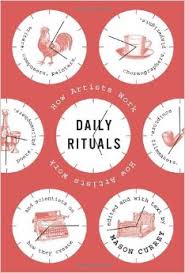 For years daily rituals have fascinated me.
For years daily rituals have fascinated me.
Was there a secret to the creative energy found in writers, poets, artists, and musicians? Would waking up earlier, staying up later, drinking lattes only after the froth had melted into an oblivion propel my creative energy into overdrive? I’m thankful to report that there’s no right or wrong way. There’s your way, and there’s mine. Nothing illustrates this more clearly than one of my favorite finds in recent years. Enter Mason Currey’s brilliant book, Daily Rituals: How Artists Work, which is the resource for the following examples of daily rituals:
Ernest Hemingway had his share of writing idiosyncrasies. “He wrote standing up, facing a chest-high bookshelf with a typewriter on top, and on top of that a wooden reading board. First drafts were composed in pencil on onionskin typewriter paper laid slantwise across the board; when the work was going well, Hemingway would remove the board and shift to the typewriter. He tracked his daily word output on a chart⎯’so as not to kid myself,’ he said. When the work wasn’t going well, he would often knock off the fiction and answer letters, which gave him a welcome break from ‘the awful responsibility of writing’⎯or, as he sometimes called it, ‘the responsibility of awful writing.'”
“Ann Beattie works best at night. ‘I really believe in day people and night people,” she told an interviewer in 1980.
I really think people’s bodies are on different clocks. I even feel now like I just woke up and I’ve been awake for three or four hours. And I’ll feel this way until seven o’clock tonight when I’ll start to pick up and then by nine it will be O.K. to start writing. My favorite hours are from 12:00 to 3:00 A.M. for writing.‘”
“‘To me, George was a little sad all the time because he had this compulsion to work,’ Ira Gershwin said of his brother. ‘He never relaxed.’ Indeed, Gershwin typically worked for twelve hours or more a day, beginning in the late morning and going until past midnight. He started the day with a breakfast of eggs, toast, coffee, and orange juice, then immediately began composing, sitting at the piano in his pajamas, bathrobe, and slippers. He was dismissive of inspiration, saying that if he waited for the muse he would compose at most three songs a year. It was better to work every day. ‘Like the pugilist,’ Gershwin said, ‘the songwriter must always keep in training.'”
How about you?
- Do you have writing idiosyncrasies like Hemingway?
- Are you a “night” person like Ann Beattie or are you a “day” person? {And I saved the best question for last.}
- Do you wait for your muse to appear or, like Gershwin, do you plug away every day whether you sense it’s there or not?
Please share your answer to one or all of the above questions. We would love to hear from you! Thank you for stopping by.







 We love helping your growing in your writing career.
We love helping your growing in your writing career.